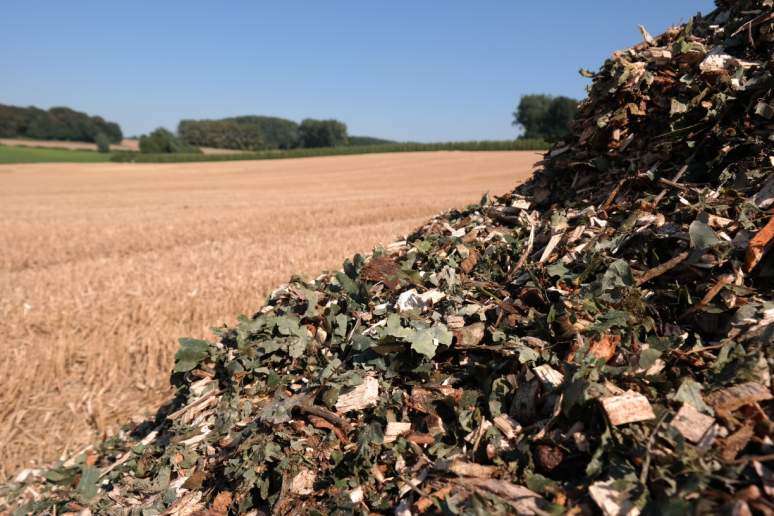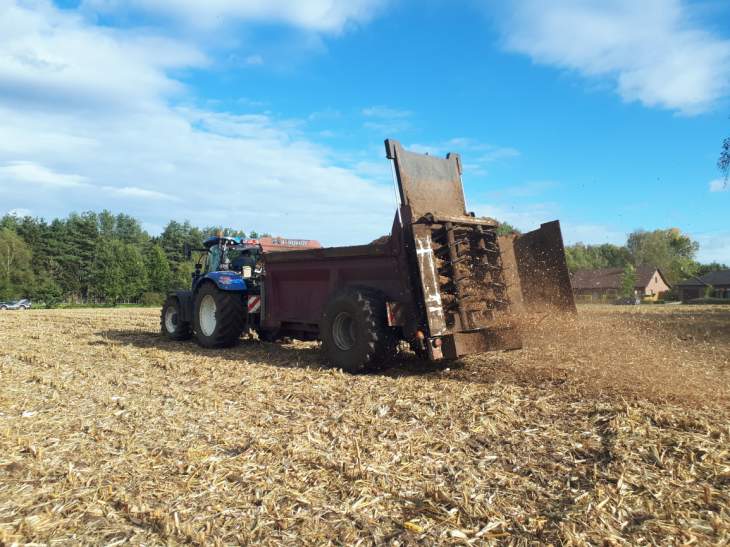Harvest residues
Crop residue addition to soil is a good source of organic matter that conserves the carbon stock in soil, helps to maintain soil moisture, and recycles nutrients.
Possible problems
Crop residue with high C:N ratio can initially immobilise the available soil nitrogen. However, if managed correctly continuous and long-term addition of crop residues leads to improved nutrient availability for subsequent crops.
Crop residues can also provide an environment where pathogens can flourish. You have to take this into consideration.
Integrated pest management (IPM) of cereal diseases (English)
Cover crops
Cover crops can be a good way to increase the soil carbon content. More information on this can be found here.
Farmyard manure
Farmyard manure (FYM) is a useful by-product of the livestock systems on a farm. It is a mixture of dung and bedding material, usually straw, although it can be other crop material or sawdust. The organic matter is a good soil addition because it provides food for earthworms as well as adding organic matter. Most forms of Farmyard manure have high drymatters and can be stacked. Other forms such as slurry are wetter , contain less organic matter and are potentially more polluting because nutrients are easily leached. The nutrient content will be influenced by animal type, animal feed and frequency of new straw being added and so it can be of variable fertiliser value. Common values are shown here Using farmyard manure (FYM) | AHDB
Machinery used
FYM is spread mechanically using manure spreaders. These spread evenly over the field. Application should not be carried out when the ground is wet due to the weight of machinery and risk of pollution of water courses. Although some machines do have metering equipment, application rates are not as precise and dependent on the material type and moisture.
Compost
Composted organic matter can be produced from farmyard manure, crop by-products, garden waste, green waste of households and a mixture of all sources. Heaped material is allowed to heat up through growth of natural bacteria and reaches temperatures of 50°C for 4-5 days, it is then moved to mix and restart the heating process. This heating destroys microorganisms and seeds. The heating process helps break down more lignified material like wood and straw making it more easily broken down in the soil but also making nutrients more stable and less likely to leach.
Compost and Digastate in Agriculture: Good Practice Guide I WRAP (English)
Movie: Reasons to use compost on your field (Dutch)
Machinery used
Compost turning machines or windrowers can be used to move the whole heap. In a more simplistic version, tractors and loaders or diggers can be used. Compost is spread with the same equipment as farmyard manure.
Wood chips
 Wood chips are made of fresh wood without the leaves. Wood chips roughly consist of half water, the other half consists of about 50% carbon (C), 1% nitrogen (N) and 0.2% phosphate (P2O5). Wood chips therefore have a high C/N ratio (50 to even 150 depending on the type of wood) and a very high C/P ratio (200 to over 2000). In other words, they bring a lot of carbon and almost no nitrogen or phosphate. Because micro-organisms use the nitrogen from the soil to decompose the wood chips, they can even provide temporary nitrogen immobilisation, nitrogen that the crop also needs to grow. It is therefore advisable to apply wood chips in the autumn to capture the residual nitrogen, immobilise it and reduce leaching. Furthermore, it is also important to think about how you fit this into your crop rotation. Taking into account the availability of wood chips, the recommended dose is 40-45 m³ (± 10-15T) wood chips per ha every four to five years.
Wood chips are made of fresh wood without the leaves. Wood chips roughly consist of half water, the other half consists of about 50% carbon (C), 1% nitrogen (N) and 0.2% phosphate (P2O5). Wood chips therefore have a high C/N ratio (50 to even 150 depending on the type of wood) and a very high C/P ratio (200 to over 2000). In other words, they bring a lot of carbon and almost no nitrogen or phosphate. Because micro-organisms use the nitrogen from the soil to decompose the wood chips, they can even provide temporary nitrogen immobilisation, nitrogen that the crop also needs to grow. It is therefore advisable to apply wood chips in the autumn to capture the residual nitrogen, immobilise it and reduce leaching. Furthermore, it is also important to think about how you fit this into your crop rotation. Taking into account the availability of wood chips, the recommended dose is 40-45 m³ (± 10-15T) wood chips per ha every four to five years.
Machinery used
A standard manure spreader can be used to spread the wood chips. Basicly there are 3 types: with horizontal rollers, with vertical rollers and with trays or platters (or a combination of rollers and trays). All types can be used. It is mainly important that there are no blockages in the transport system of the spreader or on the trays. In order to have a homogeneous spreading pattern, the spreader may not lose any wood chips due to shocks when turning on the headlands (when the transport system is switched off, the rollers will still rotate). And you also can have an overlapping spreading pattern. A well-adjusted machine and the experience and accuracy of the driver are therefore crucial here.
combination of rollers and trays). All types can be used. It is mainly important that there are no blockages in the transport system of the spreader or on the trays. In order to have a homogeneous spreading pattern, the spreader may not lose any wood chips due to shocks when turning on the headlands (when the transport system is switched off, the rollers will still rotate). And you also can have an overlapping spreading pattern. A well-adjusted machine and the experience and accuracy of the driver are therefore crucial here.
A scale on the spreader can also help to get a homogeneous spread. If you want to go a step further, you can use a spreader with task cards after a soil scan. In this way, plots with lower organic matter will get more wood chips than plots with higher organic matter.
The wood chips should also be worked under shallowly. This can be done with a standard cultivator or a rotary harrow. This can be done in 1 movement with the sowing of a cover crop.